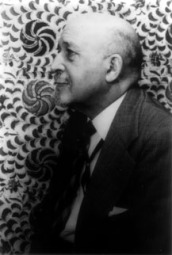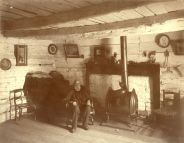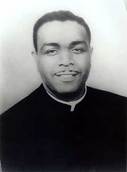BLACK HISTORY MONTH PAPER
ASSIGNMENT: Write three half-page essays (one half page on each topic) about your research on Kansas Black History. Post these to your blog and submit the URL to this assignment.

LANGSTON HUGHES
Langston Hughes, an African American writer and poet, was born in Joplin, MO, February 1-st, 1902, but grew up in Lawrence Kansas and is generally considered a Kansas. He grew up in Lawrence, Kansas living with his grandmother, Mary Sampson Patterson Leary Langston, was a prominent figure of the African American community there. After her passing Langston moved to Cleveland, Ohio with his mother and step-father where he attended Central High School and became involved with the school’s magazine called the “Monthly.” It was over this period his interest in writing developed further and his writing skills began to mature.
Hughes began attending Colombia University in the fall of 1921 but had already written one of his more famous poems titled, The Negro Speaks of Rivers. He only stayed in college a year, then went on to become a key figure in the arts scene of Harlem, often publishing his works in such magazines as “Crisis” and “Opportunity.” His poem “The Weary Blues” won 1-st place in Opportunity magazine’s literary contest which launched his career as a writer.
Some of his major works are “The Big Sea,” an autobiography; “Not Without Laughter,” his first novel about an African boy he called “Sandy”  growing up in small town Kansas; and “Selected Poems of Langston Hughes” which is a collection of poems from Hughes earlier works. He produced an extensive number of well received writings over the years but wrote predominantly for the theater through the 1930’s and his “Mulatto” was the longest running Broadway play written by an African American on into 1958.
growing up in small town Kansas; and “Selected Poems of Langston Hughes” which is a collection of poems from Hughes earlier works. He produced an extensive number of well received writings over the years but wrote predominantly for the theater through the 1930’s and his “Mulatto” was the longest running Broadway play written by an African American on into 1958.
While Hughes managed to live as a writer he never really made a whole lot of money from his trade. It wasn’t until 1947 he had finally earned enough to purchase a home of his own in Harlem, which had always been his dream. In his later years he was deemed the “Poet Laureate of the Negro Race,” a title he encouraged, and he was thought of as the most original of all African American Poets. He died after having had abdominal surgery on May 22-nd, 1967.
SAMUEL LYLE ADAIR
Samuel Lyle Adair became a minister in 1816 at Oberlin College (a leading anti-slavery school) in Ohio where he had also met his wife Florella Brown Adair. He and his family moved to Kansas in 1854 eventually settling in Osawatomie. Samual’s personal views on slavery in combination with his connection to Florella’s half-brother, John Brown, famed abolitionist, placed him at the center of the storm in regarding the anti-slavery movement.
Their cabin, a typical rough, frontier log cabin, eventually came to serve as a headquarters of the Underground Railroad in the times known as “Bleeding Kansas.” After the “sacking” ofOsawatomie by pro slavery forces and the subsequent burning of the town on August 30, 1856, the Adair cabin was the only free state home left standing due  primarily to the medical services Florella performed there. It was more or less like the area hospital, housing a number of patients there, so it was allowed to be spared.
primarily to the medical services Florella performed there. It was more or less like the area hospital, housing a number of patients there, so it was allowed to be spared.
The Adair cabin is now the the John Brown Museum, State Historic Site. The museum’s displays tell the story of John Brown, the Adair Family and local abolitionists. The site and includes the original cabin, Adair family furnishings and belongings, and collections of numerous Civil War artifacts.
BROWN v. BOARD OF EDUCATION OF TOPEKA

 Brown v. Board of Education of Topeka was a landmark decision of the United States Supreme Court that declared state laws establishing separate public schools for black and white students unconstitutional. Oliver L. Brown was the one who raised the issue as his daughter Linda Brown had to walk through a train switching yard just to get on a bus to go to her school when there was an all white school just a few blocks from their home. He brought together 13 Topeka parents on behalf of their 20 children and took their complaints to the NAACP who fought for their cause initially filing the class action suit in 1951.
Brown v. Board of Education of Topeka was a landmark decision of the United States Supreme Court that declared state laws establishing separate public schools for black and white students unconstitutional. Oliver L. Brown was the one who raised the issue as his daughter Linda Brown had to walk through a train switching yard just to get on a bus to go to her school when there was an all white school just a few blocks from their home. He brought together 13 Topeka parents on behalf of their 20 children and took their complaints to the NAACP who fought for their cause initially filing the class action suit in 1951.
By 1953 the case was before the US Supreme Court which reviewed four state cases in which African-American minors sought admission to the local public schools on a non-segregated basis. In each instance, they had been denied admission to schools attended by white children under laws requiring or permitting segregation according to race. This segregation was said to deprive the minors of the equal protection of the laws under the Fourteenth Amendment and in each case, with the exception the Delaware case, the district court originally denied relief to the minors on the “separate but equal” doctrine announced by the Supreme Court in a previous decision, Plessy v. Ferguson.
In Brown v. Board of Education of Topeka, the minors contended that the public schools were not equal and could not be made equal, thereby denying them equal protection of the law in violation of the United States Constitution. The legal question in these cases was whether Plessy should be held inapplicable to public education and whether segregation of children in public schools solely on the basis of race, even though the physical facilities and other tangible factors were equal, deprived the children of minority groups of equal educational opportunities.
The United States Supreme Court found Plessy v. Ferguson as well as the “separate but equal” doctrine to be unconstitutional, determining they had no place in public education. In a 9-0 unanimous decision segregation in public schools was found to be a denial of equal protection of the laws under the Fourteenth Amendment and segregated educational facilities were held to be inherently unequal.
COMMENTS: Comments Posted to the following blogs regarding this assignment.
Brian: http://www.ikaleidoscopedesign.com/?p=527
(No other assignments posted to comment on as of tonight, 02/17/2012)












I’ve never heard of Samuel Adair. I think it is cool that you chose a subject who is generally unknown.
Today, I went to the beachfront with my kids.
I found a sea shell and gave it to my 4 year old daughter
and said “You can hear the ocean if you put this to your ear.” She put the shell to
her ear and screamed. There was a hermit crab inside and it
pinched her ear. She never wants to go back! LoL I know this
is totally off topic but I had to tell someone!